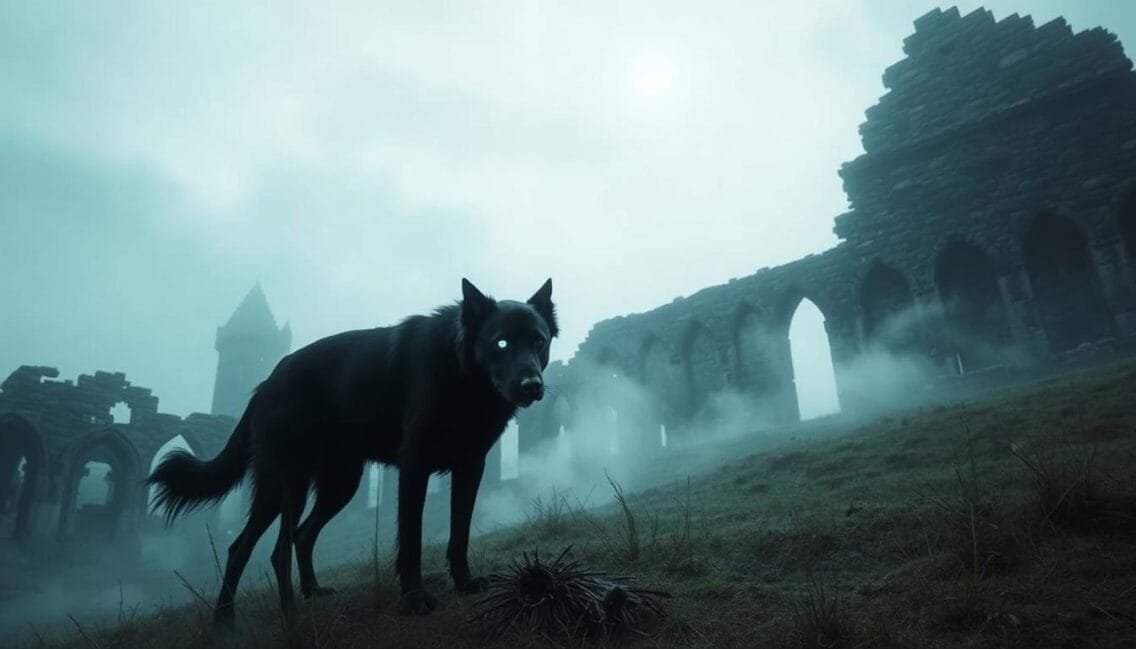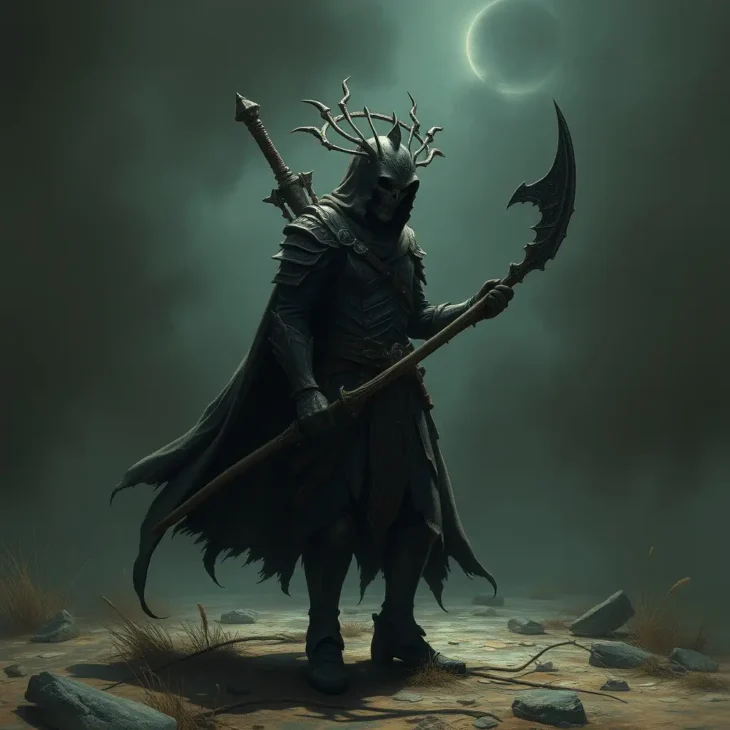Black Dog Sightings in English Folklore

Growing up in the English countryside, I’ve always been fascinated by tales of mysterious black hounds. These spectral canines, known as “Black Dogs,” have captured the British imagination for centuries. Sightings are reported all over the nation.
As I explore Black Dog folklore, I’m excited to learn about their origins and significance. These supernatural encounters have become a big part of English culture.
From Yorkshire’s windswept moors to East Anglia’s haunted forests, Black Dog legends are everywhere. Each region has its own twist on the ghostly hound’s look and actions. What makes these black-furred, glowing-eyed creatures so captivating to the British for centuries?
As we dive into the Black Dog’s role in English folklore, we’ll discover its Celtic roots. We’ll also see how medieval tales have shaped the legends we know today.
Key Takeaways
- Black Dog sightings have been reported across England for centuries, with regional variations in the legends
- These ghostly hounds are deeply rooted in Celtic mythology and have evolved over time through medieval folklore
- The Black Dog’s physical characteristics, supernatural powers, and association with death omens are central to the legends
- Black Dog sightings have had a significant cultural impact, inspiring literature, tourism, and paranormal investigations
- Understanding the history and folklore of the Black Dog can provide insights into the enduring appeal of the supernatural in British culture
The Origins of Black Dog Legends in British Culture
The tales of the mysterious Black Dog have been part of British folklore for centuries. These ghostly dogs come from the ancient traditions of the Celtic people in the British Isles. They are found in Scotland’s misty moors and Wales’ rugged landscapes, shaping the region’s culture.
Ancient Celtic Influences on Black Dog Mythology
The Black Dog legend starts in Celtic mythology. Here, these dogs were linked to the underworld and death. Seeing a Black Dog was believed to mean death or doom was coming.
Medieval Development of the Black Dog Legend
Over time, the Black Dog legend grew, changing in the medieval era. These dogs were seen as spirits of sinners or evil forces. Stories of them haunting castles and churchyards thrilled people back then.
Regional Variations in Early Folklore
In Britain, the Black Dog legend varied by region. The Barghest of northern England and the Padfoot of Yorkshire were different, yet all were feared. They shared a common eerie presence in local folklore.
The Black Dog, a figure of dread and fascination, has long haunted the collective consciousness of the British people, its origins steeped in the mists of Celtic mythology and its legacy woven through the tapestry of medieval legend.
Physical Characteristics of the Spectral Hounds
In British folklore, the British ghost hound is a standout. These phantom dog sightings are eerie, with a spectral canine look that sends shivers down your spine.
These ghostly British ghost hounds are huge. People say they’re bigger than regular dogs, sometimes as big as a small pony. Their size makes them seem even more menacing.
Their color is also striking. Some are black as coal, while others have glowing red eyes and a glowing body. This makes them seem even more supernatural, leaving people feeling scared.
Despite their different looks, the British ghost hound is always mysterious and frightening. It’s a phantom dog that keeps people’s imaginations running wild.
Famous Black Dog Sightings in English Folklore
England’s folklore is filled with stories of ghostly dogs. Each has its own special tale. From the scary Black Shuck in East Anglia to the mysterious Padfoot in Yorkshire and the Barghest in Northern England, these dogs have fascinated many. Let’s explore the stories behind these famous sightings.
The Black Shuck of East Anglia
In East Anglia, a coastal area, there’s a legend about the Black Shuck. It’s a huge, black dog with glowing red eyes. People say it roams the streets, warning of bad luck or death. For centuries, its sightings have been a part of local stories.
Padfoot of Yorkshire
In Yorkshire, the Padfoot is a different story. It’s a friendly ghost dog that helps travelers at night. Unlike the Black Shuck, Padfoot is seen as a guardian, not a sign of doom.
The Barghest of Northern England
The Barghest is found in Northern England and is quite scary. It’s a big, black dog with glowing red eyes and sharp teeth. Seeing the Barghest is often linked to sad events, making it a symbol of the supernatural.
These ghost dogs have captured the hearts of many Britons. Their stories show the power of these creatures to inspire awe and fear. They are a big part of England’s folklore.
Supernatural Powers and Abilities Associated with Ghost Hounds
The legends of ghostly dogs have long fascinated many. These dogs, known as “black dogs” in British folklore, have many strange powers. These powers make them mysterious and scary.
One famous ability of these supernatural canines is shape-shifting. They can change from a small dog to a huge beast. This power makes them even more mysterious and frightening.
Another interesting trait is their invisibility. Folklore stories say these paranormal abilities let them disappear. They only show up with strange sounds or a feeling of doom. This invisibility helps them sneak up on people, adding to the fear.
“The black dog is a manifestation of the unknown, a harbinger of things to come. Its mere presence is enough to strike fear into the hearts of the bravest souls.”
Black dogs are also thought to have the power to predict the future. They can see what’s coming, including death. This ability makes them even more feared and fascinating.
The strange powers of black dogs in British folklore make them unforgettable. They continue to amaze and scare those who hear about their ghostly powers.
The Black Dog as a Death Omen in British Tradition
In English folklore, the Black Dog is seen as a sign of death. These ghostly dogs, known as “Grim sightings,” have a long history. They are believed to predict when someone’s life will end.
From old Celtic stories to today, the Black Dog’s link to death has fascinated people. It has been a part of British culture for centuries.
Historical Death Predictions
Stories of the Black Dog’s arrival before death go back to the Middle Ages. Tales of these ghostly apparitions, known as “death omens,” were often recounted in remote villages, where the appearance of a large, dark canine was seen as a chilling premonition of impending mortality. These sightings were thought to be a warning from beyond the grave, a last look at life before it ends.
Modern Interpretations of the Death Omen
Even though the belief in the Black Dog’s powers has faded, the legend still holds people’s interest. In today’s Britain, the Black Dog premonitions are seen as symbols of depression, anxiety, or death’s shadow. The ongoing interest in these death omens shows our eternal quest to grasp and face death’s mysteries.
Geographic Distribution of Black Dog Sightings
Exploring Black Dog folklore, I found these ghostly dogs are everywhere in the British Isles. They roam from East Anglia’s coastlines to Yorkshire’s hills. These sightings have woven themselves into local legends and ghost stories.
The Black Dog sightings map shows a clear pattern. Places like the Norfolk Broads and North Yorkshire Moors have lots of sightings. This might mean there are special cultural, geographic, or geological reasons for these sightings.
“The Black Shuck of East Anglia is perhaps the most well-known of these regional ghost hounds, with countless tales of its eerie appearances in coastal towns and villages.”
But other areas, like the Midlands or South, see fewer Black Dog sightings. This uneven spread makes us wonder about the reasons behind it. It could be linked to the local environment and how it affects these ghostly dogs.
As I dig deeper into the Black Dog mystery, I believe understanding where they are seen is key. By studying their spread, we might uncover more about British supernatural beliefs. This could help us understand the lasting impact of these stories.
Cultural Impact and Literary References
The Black Dog legends have made a lasting impact on literature and popular culture. Sir Arthur Conan Doyle, the creator of Sherlock Holmes, is a key figure. His novel The Hound of the Baskervilles brings these ghostly hounds to life, captivating readers.
The Black Dog has also appeared in modern media. It’s seen in the Harry Potter series as the Grim and in Supernatural as the Hellhound. These appearances have made the Black Dog a favorite among fans. They’ve also boosted local tourism in England, with tours and walks exploring the Black Dog’s legend.
The Black Dog’s influence is clear in literature, film, and TV. These mysterious creatures have moved beyond folklore. They’ve become a part of our shared imagination, shaping how we see the supernatural.
Sir Arthur Conan Doyle’s Influence
The Hound of the Baskervilles by Sir Arthur Conan Doyle has greatly influenced the Black Dog in literature. Its chilling story of a ghostly hound has made it a classic horror tale. It has captivated readers for many years.
Modern Media Portrayals
The Black Dog has appeared in modern media, like the Grim in Harry Potter and the Hellhound in Supernatural. These roles have solidified its status as a symbol of the supernatural.
Impact on Local Tourism
The Black Dog’s legend has boosted folklore tourism in England. Guided tours and ghost walks explore these stories. They attract both locals and visitors, making them a popular attraction.
Scientific and Paranormal Investigations
The Black Dog sightings in English folklore have always fascinated people. Both paranormal researchers and cryptozoologists are trying to understand these mysterious hounds. They aim to uncover the truth behind the legends.
Some scientists think that natural explanations could explain the Black Dog sightings. They believe that large dogs or black bears might be mistaken for these hounds. Others think that optical illusions or mass hysteria could also play a role. Yet, many people find these explanations unsatisfying, especially when credible witnesses share their experiences.
“The Black Dog is more than just a figment of our imagination. Its appearance has been documented for centuries, and the experiences of those who have encountered it are too numerous and consistent to dismiss.”
Paranormal researchers, however, believe in the supernatural nature of the Black Dog. They look into the folklore’s ties to ancient Celtic deities. They also consider the possibility that these hounds can predict death. While these ideas are still speculative, they attract those interested in the paranormal side of the legend.
The debate over the Black Dog continues, captivating the public’s interest. This ongoing fascination drives paranormal research, cryptozoology, and Black Dog investigations.
Conclusion
The legacy of Black Dog folklore in England is a mystery that fascinates people worldwide. It has Celtic roots and has evolved over centuries. This ghostly hound is a key part of British culture.
The Black Dog’s presence can send shivers down your spine. It has appeared in many stories and movies. But, its true story and purpose are still unknown, making it even more intriguing.
Looking back at Black Dog folklore, I see its lasting appeal. These mysterious dogs have captivated people for ages. They show our deep interest in the unknown and our love for stories.





